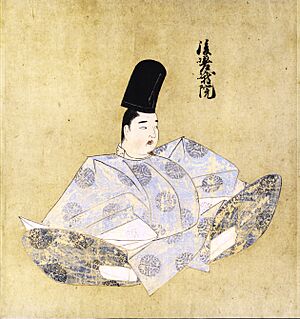Emperor Go-Saga facts for kids
Quick facts for kids Emperor Go-Saga後嵯峨天皇 |
|||||
|---|---|---|---|---|---|

Go-Saga, Tenshi Sekkan Miei
|
|||||
| Emperor of Japan | |||||
| Reign | February 21, 1242 – February 16, 1246 | ||||
| Coronation | April 19, 1242 | ||||
| Predecessor | Shijō | ||||
| Successor | Go-Fukakusa | ||||
| Shōgun | Kujō Yoritsune Kujō Yoritsugu |
||||
| Born | April 1, 1220 | ||||
| Died | 17 March 1272 (aged 51) Daikaku-ji (大覚寺), Heian-kyō |
||||
| Burial | Saga no minami no Misasagi (嵯峨南陵) (Kyoto) | ||||
| Spouse |
Fujiwara no Kitsushi
(m. 1242) |
||||
| Issue more... |
|||||
|
|||||
| House | Yamato | ||||
| Father | Emperor Tsuchimikado | ||||
| Mother | Minamoto no Michiko | ||||
Emperor Go-Saga (後嵯峨天皇, Go-Saga-tennō), born April 1, 1220, and died March 17, 1272, was the 88th emperor of Japan. He ruled from 1242 to 1246.
His name, "Go-Saga," means "Later Saga" or "Saga the Second." This connects him to an earlier emperor from the 8th century, Emperor Saga.
Contents
Family and Children
Before he became emperor, his personal name was Prince Kunihito (邦仁親王). He was the second son of Emperor Tsuchimikado.
Emperor Go-Saga had many children. His main empress was Saionji (Fujiwara) no Kitsushi (西園寺(藤原)姞子). She was also known as Ōmiya-in.
Some of his important children included:
- Prince Hisahito (久仁親王), who later became Emperor Go-Fukakusa.
- Prince Tsunehito (恒仁親王), who later became Emperor Kameyama.
- Prince Munetaka (宗尊親王), who became a shōgun.
Key Events of Go-Saga's Reign
Go-Saga ruled as emperor from February 21, 1242, to February 16, 1246.
When he was young, his father, Emperor Tsuchimikado, moved to Tosa Province. So, Go-Saga was raised by his mother's family.
Becoming Emperor
In 1242, the previous emperor, Emperor Shijō, died suddenly at only 10 years old. This created a big problem: who would be the next emperor?
The court nobles in Kyoto and the military government (called the Bakufu) had different ideas. Kujō Michiie and the court nobles wanted Prince Tadanari to be emperor. However, the shikken (a powerful regent) Hōjō Yasutoki did not agree. He didn't want any sons of the former Emperor Juntoku to rule because of their family's past involvement in a conflict called the Jōkyū War.
Instead, Hōjō Yasutoki supported Prince Kunihito (Go-Saga) because he was seen as a neutral choice. There was a delay of 11 days before a decision was made.
- February 11, 1242: Emperor Shijō died.
- April 19, 1242: Prince Kunihito officially became Emperor Go-Saga.
Ruling as Cloistered Emperor
In 1246, Emperor Go-Saga decided to step down from the throne. He passed the role to his son, Emperor Go-Fukakusa. Even after stepping down, Go-Saga continued to hold real power behind the scenes as a cloistered emperor. This meant he still guided the government.
In 1259, Go-Saga convinced Emperor Go-Fukakusa to also step down. Go-Fukakusa's younger brother, Emperor Kameyama, then became the new emperor.
Go-Saga also made an important change: his son, Prince Munetaka, became the shōgun. Before this, the shōgun had always been chosen from the Hōjō family. From then on, the shōguns of the Kamakura military government came from the imperial family. However, the Hōjō regents still kept a lot of control over the government.
Imperial Family Split
After Go-Saga's death, his two sons, Emperor Go-Fukakusa and Emperor Kameyama, had descendants who both wanted to be emperor. This led to a big disagreement and split the imperial family into two main lines:
- The Jimyōin-tō (descendants of Go-Fukakusa)
- The Daikakuji-tō (descendants of Kameyama)
This split eventually led to the period of the Northern and Southern Courts, where Japan had two rival imperial courts for many years.
Important Court Officials
The Kugyō (公卿) was a small group of the most powerful men in the emperor's court. Even when the emperor's direct power was limited, these officials held important positions.
During Go-Saga's reign, this group included:
- Kampaku (chief advisor to the emperor): Konoe Kanetsune (1242), Nijō Yoshizane (1242–1246), Ichijō Sanetsune (1246)
- Sadaijin (Minister of the Left)
- Udaijin (Minister of the Right)
- Nadaijin (Minister of the Center)
- Dainagon (Great Counselors)
Eras During His Reign
In Japan, years are also identified by special era names called nengō.
Death and Burial
Emperor Go-Saga died in 1272. His final resting place is an Imperial mausoleum (misasagi) called Saga no minami no Misasagi. It is located near Tenryū-ji in Kyoto.
See also
 In Spanish: Go-Saga Tennō para niños
In Spanish: Go-Saga Tennō para niños
- Emperor of Japan
- List of Emperors of Japan
- Imperial cult


